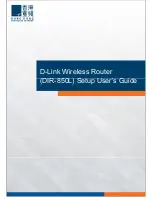
D-Link DIR-301 User Manual
Section 1 - Product Overview
Introduction
D-Link, the industry leader in wireless networking, introduces another breakthrough in wireless connectivity. The
D-Link Wireless G DIR-301 Router which is capable of transferring data with a maximum wireless signal rate of up to
54Mbps* in the 2.4GHz frequency — the same wireless frequency as 802.11b. The D-Link DIR-301 Wireless Router
also offers four Ethernet ports to support multiple computers.
The advanced wireless technology built into the DIR-301 Wireless Router offers data transfer speeds with a maximum
wireless signal rate of up to 54Mbps* through its wireless channels allowing streaming videos and other high bandwidth
applications, such as online gaming events, to operate without the hassle of Ethernet cables. The ability to use high
bandwidth applications also makes streaming real-time programs more enjoyable and more efficient.
With the DIR-301 Wireless Router’s built-in advanced firewall, threats of hackers penetrating your network are minimized.
Some firewall features include functions that allow or disallow certain ports to be open for certain applications. Time
scheduling can be established as a firewall rule so that specific ports will be open at certain times and be closed at
other times. Features like content filtering, MAC filtering, URL blocking, and domain blocking are useful tools to prevent
other unwanted intruders from connecting to your network or browsing restricted sites.
The easy-to-use configuration wizard takes only minutes to setup and guides users step-by-step through configuring the
DIR-301. With all the versatile features and an user-friendly utility, the DIR-301 Wireless Router provides an enhanced
networking experience.
* Maximum wireless signal rate derived from IEEE Standard 802.11g specifications. Actual data throughput will vary. Network conditions and
environmental factors, including volume of network traffic, building materials and construction, and network overhead, lower actual data throughput
rate. Environmental conditions will adversely affect wireless signal range.






































